#The National Geographic
Explore tagged Tumblr posts
Text
At Long Last, The American Buffalo Has Come Home
A conservation effort has returned bison to Blackfeet Nation tribal lands more than a century after the animal was nearly slaughtered to extinction.
— Photographs By Louise Johns | By Lailani Upham | Sunday July 09, 2023
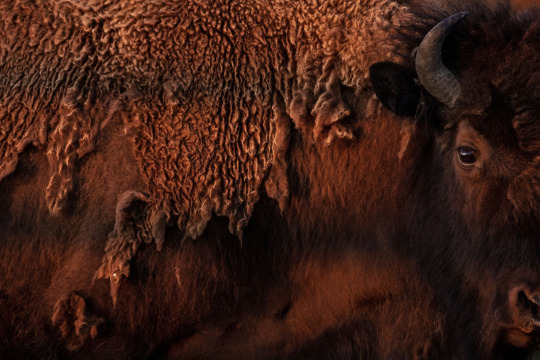
“Nititawahsi” is the Blackfeet name for our land—the land where the iinnii (buffalo) live. Our people are Niitawahsin-nanni: the people of the land where the iinnii live.
As colonizers moved west, millions of buffalo were killed and brought to the edge of extinction. Millions more Native peoples were murdered, displaced, and forced to assimilate. By the end of the 19th century, only 300 buffalo were left in the wild and Native populations dropped to less than 300,000.
Now, after more than 150 years, iinnii have finally returned to their homeland, the Amskapi Pikuni (Blackfeet Nation) tribal lands, to roam free.

Forty-nine buffalo run out of their temporary enclosure towards Chief Mountain on the Blackfeet Reservation. The rest of the herd (about 70 buffalo) will join them at the end of the summer. Chief Mountain is not only prime buffalo habitat, but also a sacred place for Native people in both the U.S. and Canada.
“I can’t hardly describe the feeling that I have. I have this jittery feeling, goosebumps,” says Ervin Carlson, director of the Blackfeet Nation Buffalo Program. “It just feels so good to finally see them here in this place where we want them to be.”
On June 26, 49 iinnii were released into the wild at the base of our sacred Ninaistako (Chief Mountain), a Strong Miistaaki (Mountain) that stands tall like the warbonnets of Blackfeet warriors. This miistaaki towers along the border of the Blackfeet Nation, Glacier National Park in Montana, and Waterton National Park in Canada.
Our people, the Siksikaitsitapi (Blackfoot Confederacy) always believed the land we came from was a gift of the Creator, Ihtsi-pai-tapi-yopa. Our stories tell us that iinnii was created as a gift for our people as our life source. The iinnii were and still are our staff of life.
The iinnii coming back and being free on Blackfoot lands again is the beginning of reconciliation, says Cristina Mormorunni, director of Indigenous Led, the organization that leads cultural restoration and conservation of buffalo on Blackfoot lands. “This is the beginning of the truth being told about what happened, and they’re the best ambassadors,” she says.


Helen Augare, a Blackfeet knowledge keeper and director of the Blackfeet Community College Native Science Field Center, has been an integral voice in the return of buffalo to Chief Mountain for the past 15 years.
Now that the buffalo are free, she says “there’s so much still to reconnect to and learn from them.”
“What does that future look like and what [do] our children and grandchildren need to know to be able to help iinnii live a full and prosperous life with us again?” Augare says. “It entailed everything from healthy people, healthy land, healthy water, and most of all healthy relationships. That in itself requires a lot of healing, growth.”
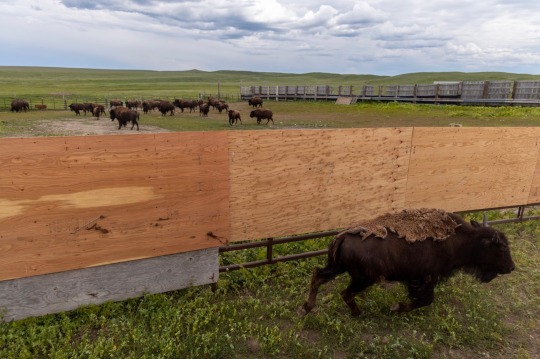
Buffalo are corralled and sorted (calves from adults, and males from females) at the tribal-owned Buffalo Spirit Hills Ranch on June 25, 2023. The herd, originally from Canada’s Elk Island National Park, have been living on the ranch since 2016. The herd descends from the last remaining wild buffalo before they were nearly extirpated.

Blackfeet tribal member Wyett Wippert takes a photo of his daughter, Ruby, in front of the buffalo in their soft release pen at Chief Mountain. “We put so much of our hearts into getting them here,” he says. “It’s a very good feeling knowing that they are under Chief Mountain. People know what they’re going to be doing for their environment and for us as Blackfeet people.” The buffalo are held here for several hours to settle into their surroundings before being released into the wild.
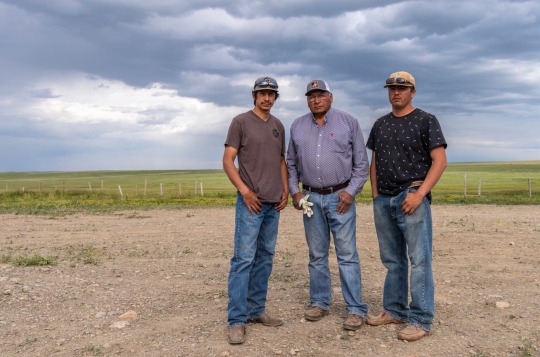
Racine, Monroe, and director Ervin Carlson of the Blackfeet Buffalo Program, on June 25, 2023, after a long day of preparing buffalo to be released at Chief Mountain. “It’s a lot of work to get these animals to this point… they are wild buffalo,” Racine says. “Nobody can do it by themselves. It’s a real honor to be able to have the Iinnii here and to be doing this.”
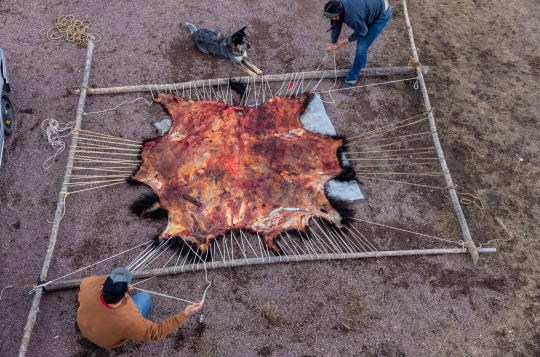
Blackfeet tribal members Wyett Wippert and Christen Falcon work together to stretch their bison hide onto their handmade wooden frame, the first step in tanning the hide by hand at their home in East Glacier, Montana. on April 9, 2023.
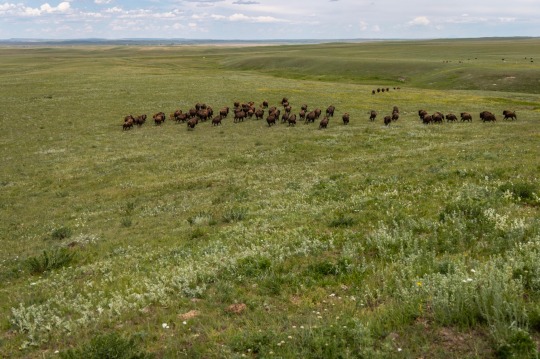
“Bison are a keystone species, they are ecosystem drivers and engineers. They were here for thousands of years,” says Brandon Kittson, wildlife biologist for Blackfeet Fish and Wildlife. “Now having them back on this landscape is a good thing. It’s going to help revitalize some systems and help drive diversity among the different vegetation and communities found in this area.”
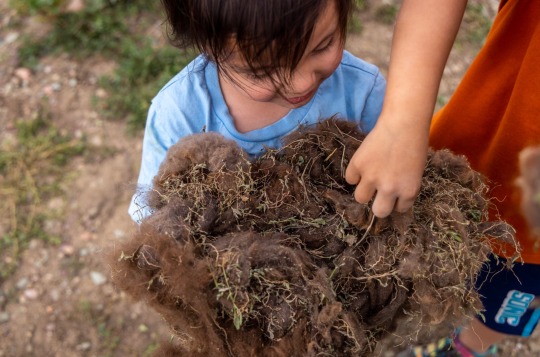
Children collect and examine clumps of buffalo fur from the corral at Buffalo Spirit Hills Ranch on June 25, 2023. The fur is integral to the health of the grassland ecosystem, as certain species of birds use it to line and insulate their nests.
— Photojournalist Louise Johns is a National Geographic Explorer. Her National Geographic Society-funded Project, "Buffalo Renaissance," is about Native American efforts to restore Bison to build cultural resiliency and ecological integrity.
#The National Geographic#American Buffalo#Photojournalist#Louise Johns#Buffalo Renaissance#Amskapi Pikuni (Blackfeet Nation)#Niitawahsin-Nanni#Chief Mountain#Ninaistako (Chief Mountain)#Glacier National Park in Montana#Waterton National Park in Canada#The Siksikaitsitapi (Blackfoot Confederacy)#Cristina Mormorunni#Helen Augare#Montana USA 🇺🇸#Canada 🇨🇦#Brandon Kittson Wildlife Biologist#National Geographic Explorer
33 notes
·
View notes
Text
19K notes
·
View notes
Text
21K notes
·
View notes
Text

51K notes
·
View notes
Text

"Fluid as water, brilliant as silver, heavier than lead, mercury spills through a mine worker's fingers."
National Geographic
October 1972
ph. Robert W. Madden
68K notes
·
View notes
Text
#beautiful nature#our planet#beautiful planet#beautiful place#our world#beautiful world#beautiful earth#national geographic#nature#outdoors#wilderness
5K notes
·
View notes
Text

"In Focus: World of Islam" in National Geographic Magazine (2002) Photography: Don Belt
12K notes
·
View notes
Text
One of my absolute favorite art/science collaborations in the world is a project by National Geographic and photographer Joel Sartore called the Photo Ark. The ark is a 25 year project with the goal of photographing every animal species in human care, with the hopes of saving as many endangered species as possible. The Ark turned 18 years old today and they’ve just photographed their 16,000th animal- the Santa Cruz long-toed salamander!

I really recommend any animal lovers or photography enthusiasts learn about this project and follow photographer Joel Sartore on this journey. He does an incredible job of highlighting lesser known species and his skill as an artist is staggering. The behind the scenes process of how he gets these shots of such a wide variety of species is always a technical marvel.

Also worth noting that if you’re an artist ever in need of reference photos for an obscure animal species, this is a great resource where you can look up high quality images by species name! Anyone looking to decorate their home with a focus on biology art can purchase beautiful animal prints while supporting conservation.
Here are some of my favorite shots over the years to celebrate the Ark’s birthday!








#I want this dudes job but my photography will never be on this level 🤯#animals#Photo ark#Joel Sartore#photography#wildlife photography#art#National Geographic
2K notes
·
View notes
Text



"In Slovenia’s Soča Valley, the traditional Pust festival marks the end of winter. Locals wear masks and costumes in a century-old ritual that celebrates the coming of spring.
- National Geographic
663 notes
·
View notes
Text

Phytoplankton bloom in the Barents Sea on August 14, 2011. This image was taken by the Moderate Resolution Imaging Spectroradiometer (MODIS) aboard the Aqua satellite. Photograph By NASA, GSFC/Jeff Schmaltz/Modis Land Rapid Response Team
Climate Change Will Shift The Oceans’ Colors
In the next century, satellites will watch as the ocean's blues and greens intensify.
— By Sarah Gibbens | July 21, 2023
The color of deep blue oceans, shallow turquoise waters, and emerald green coasts is quickly changing as the planet warms, according to new research published in the journal Nature.
Analyzing 20 years of satellite data, the study's authors found that over half the world's ocean, 56 percent, experienced a shift in color. The cause? Changes in the density and distribution of plankton. These tiny organisms contain chlorophyll, the bright green pigment that helps plants make food from sunlight.
The recent study supports a similar prediction made by a Nature Communications study published in 2019 that modeled how phytoplankton will change as oceans continue to warm.
And while the new study used satellites to detect subtle changes in color, the prior research predicted significant changes by 2100, if the world keeps warming at its current pace.
Under a “business-as-usual” scenario in which greenhouse gas emissions continue unabated, the bluest subtropical zones of the ocean will become bluer, and greener regions along the equator and poles will become greener, that study found.
More than just an oddity, the changing color is a warning sign, say the 2019 study authors, of drastic global changes that will take place in a world warmed by climate change.
How The Ocean Gets Its Color
Sunlight penetrates over 600 feet below the surface of the ocean. Everything deeper is enshrined in darkness. Above that, most water molecules are capable of absorbing all colors except blue, which is why blue is reflected out.
Organic matter that blankets the surface of the ocean, like phytoplankton, changes this color. As the ocean warms, currents become more irregular, and the layers in the water become more stratified, meaning warm regions don't mix as easily with cold regions.
There are thousands of phytoplankton species, uniquely adapted to warm or cold water. As oceans continue warming, some species may die off, some will thrive, and others will migrate to different regions.
But just looking at chlorophyll alone, however, won't tell scientists how a warming climate is altering phytoplankton. Naturally occurring events like El Niños and La Niñas can influence how much phytoplankton is concentrated in a given area
youtube
Stephanie Dutkiewicz, an author on both papers and marine ecologist at the Massachusetts Institute of Technology, said in 2019 that models used to predict future changes in color factor phytoplankton life cycles and movements into naturally occurring ocean patterns.
The 2023 study revealed that many of these predicted changes have already occurred. Using light-measuring devices aboard NASA satellites, scientists observed that over half of the world covered by ocean already showed a measurable shift in blue and green wavelengths, an approximation for the amount of chlorophyll in a given region.
What Do These Changing Colors Mean?
It's too early to say for sure what effect these changing colors will have on the environment, but scientists think more ecosystems could be dominated by smaller-sized plankton in the future, according to a press release from the National Oceanography Center in the U.K., which supported the 2023 study.
The ocean has absorbed about a third of the world's carbon emissions, and marine life like kelp, seagrass, and algae play a critical role in helping pull that carbon out of the atmosphere.
But smaller algae could reduce that climate change-fighting power.
“Phytoplankton are the base of the marine food web. Everything in the ocean requires phytoplankton to exist," Dutkiewicz told National Geographic in 2019. "The impact will be felt all the way up the food chain."
#Youtube#The National Geographic#Climate Change#Sarah Gibbens#Oceans’ Colors#Phytoplankton Species#El Niños | La Niñas#Stephanie Dutkiewicz#Massachusetts Institute of Technology#NASA#Scientists#Oceanography Center U.K. 🇬🇧
3 notes
·
View notes
Text
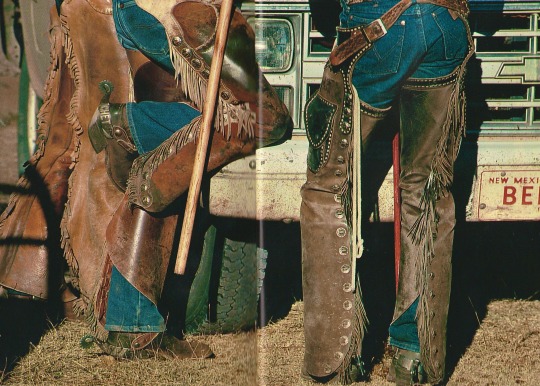
along the santa fe trail | national geographic [march 1991]
#just been scanning some images from some vintage nat geos i picked up the other day#national geographic
14K notes
·
View notes
Text
48K notes
·
View notes
Text

Young Chincoteague ponies wrestle on Chincoteague Island, part of Virginia's Eastern Shore, in the 1970s.
PHOTOGRAPH BY JAMES L. STANFIELD, NAT GEO IMAGE COLLECTION
#james l stanfield#photographer#national geographic#chincoteague ponies#horse#animal#mammal#chincoteague island#virginia#nature
1K notes
·
View notes
Text
Wait, but all I learned from the Trump tariffs is that there was a happy island of penguins living their best isolated life?

They seem happy enough.
417 notes
·
View notes
Text

Map of Palestine from the National Geographic Magazine (1947)
5K notes
·
View notes
Text
#bees#national geographic#bisexual#queen#ytp#snip#dathings#Oh Yes! Love the Bees!#bumblebee#nature#insects
506 notes
·
View notes